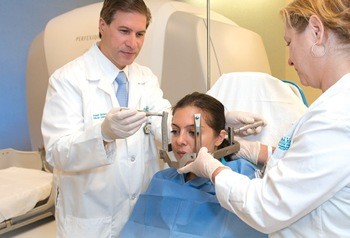- PATIENT FORMS | REQUEST A CONSULTATION | CONTACT US
- 1-844-NSPC-DOC
Trigeminal Neuralgia Differential Diagnosis: Dr. Michael Brisman
Hemifacial Spasm Treatment Options with NSPC’s Dr. Michael Brisman
December 9, 2014
Treating More Than Malignancies: The Many Benefits Of Gamma Knife Radiosurgery At South Nassau Communities Hospital
December 15, 2014What Is Trigeminal Neuralgia?
Trigeminal neuralgia is a very specific type of facial pain. Accurate diagnosis is critical because trigeminal neuralgia treatments are very different from other facial pain treatments.
Typical Trigeminal Neuralgia Features
Trigeminal neuralgia pains are sudden, sharp, severe, brief, and intermittent pains that can often be triggered by light touch. The pains are often described as radiating pains that feel like electric shocks, and the pains may go away for weeks, months, or even years. Patients usually experience these pains in the cheek or jaw, and usually only on one side of the face. The vast majority of trigeminal neuralgia patients can experience pain relief when taking Tegretol, an anti-seizure medication.
Atypical Trigeminal Neuralgia Features
In addition to the brief, sudden, severe facial pains, some trigeminal neuralgia sufferers may also experience other aches and pains in the face, and the pain may spread to the other side of the face, as well as the forehead. The pains may be very persistent and, rarely, they do not respond to Tegretol.
People with multiple sclerosis are more likely to get trigeminal neuralgia. For patients without MS, trigeminal neuralgia is usually caused by a blood vessel pressing on the trigeminal nerve in the brain, or, rarely, a tumor.
Other Diagnoses For Similar Facial Pain
It is important to consider other possibilities for facial pains that are similar to trigeminal neuralgia, so I will discuss other conditions we consider when making a differential diagnosis.
If a person has had a shingles outbreak, or a rash on the face that looks like chickenpox, it might be postherpetic neuralgia. Postherpetic neuralgia usually occurs in the elderly, and the patient feels pain in the forehead area. Although the pains may still be sudden, sharp, and severe, the illness is treated differently.
Another consideration is post-injury pain. These injuries may be a result of accidents, surgeries including dental procedures or other facial surgeries, and intentional nerve injury during trigeminal neuralgia treatment. Though the resulting pain may be sudden, sharp, and severe, it is often associated with a dull, constant ache or burning pain.
Another consideration is a group of conditions called trigeminal autonomic cephalgias. These include cluster headaches, paroxysmal hemicrania, and SUNCT syndrome. Many of these conditions involve the eyes and forehead. While Trigeminal neuralgia can involve the eye and forehead, it usually involves the lower part of the face primarily. These other conditions may also have other features such as eyelid drooping, tearing, swelling, and other symptoms.
Another consideration is glossopharyngeal neuralgia or vagoglossopharyngeal neuralgia. People with these conditions feel sharp, sudden, severe pains in the throat or deep in the ear. These pains may be set off by swallowing or touching the deep ear.
In addition, we must not overlook dental disease or TMJ. However, these conditions usually involve constant aches and pains, usually set off by talking or moving the jaw and usually localized to the gums, teeth, or forehead.
Finally, a patient may have manifest severe psychological problems as facial pain. It is more rare to diagnose such a person with trigeminal neuralgia, and these psychological manifestations are called somatoform disorders.
In summary, differential diagnosis is critical to patients experiencing facial pain. It may be trigeminal neuralgia, or it may be another condition treated differently.
